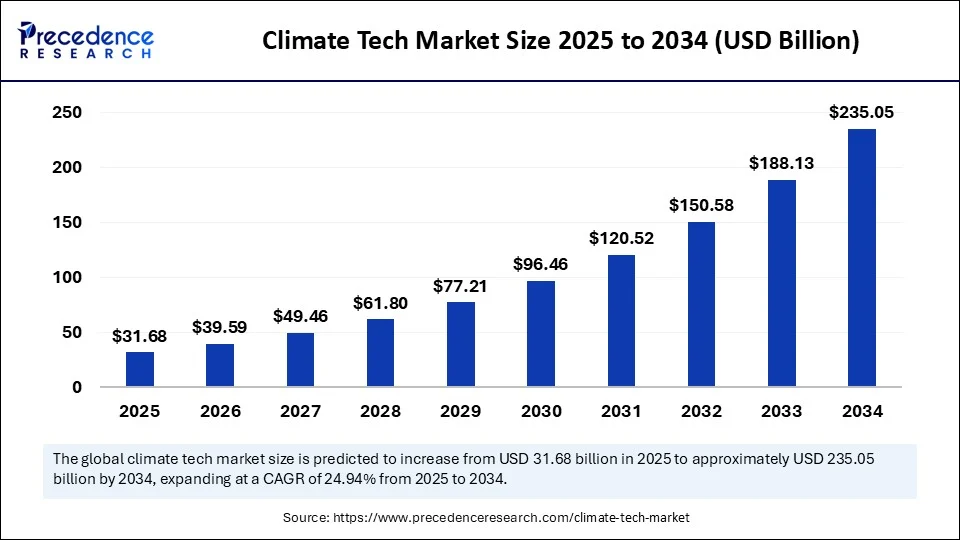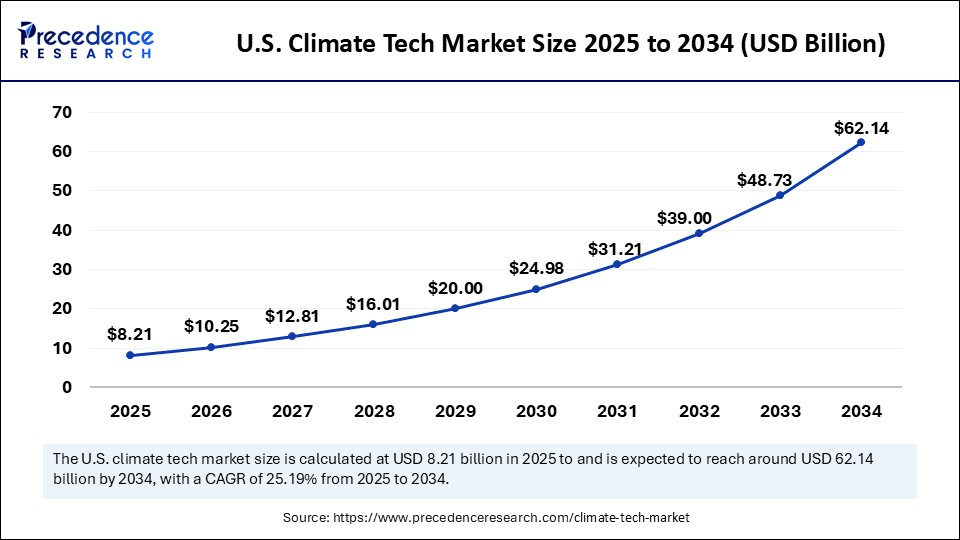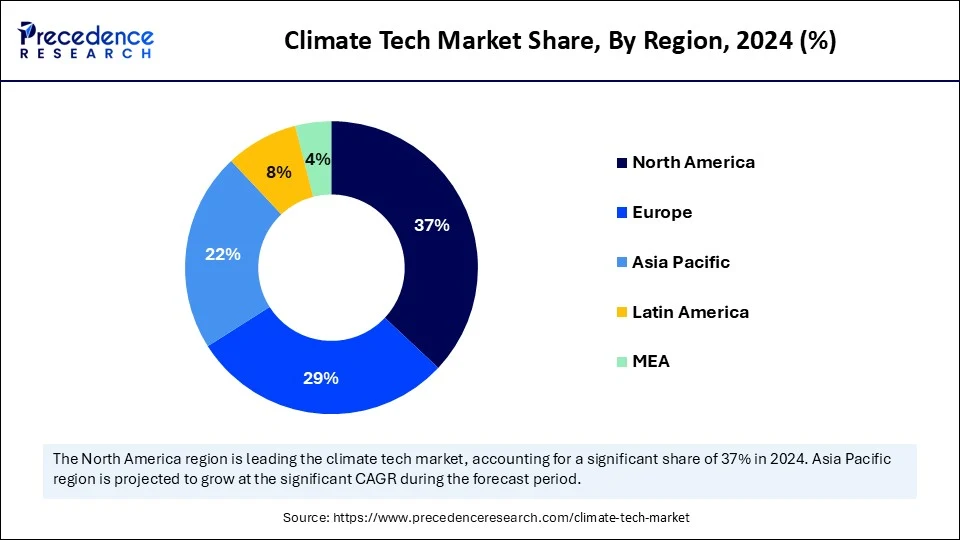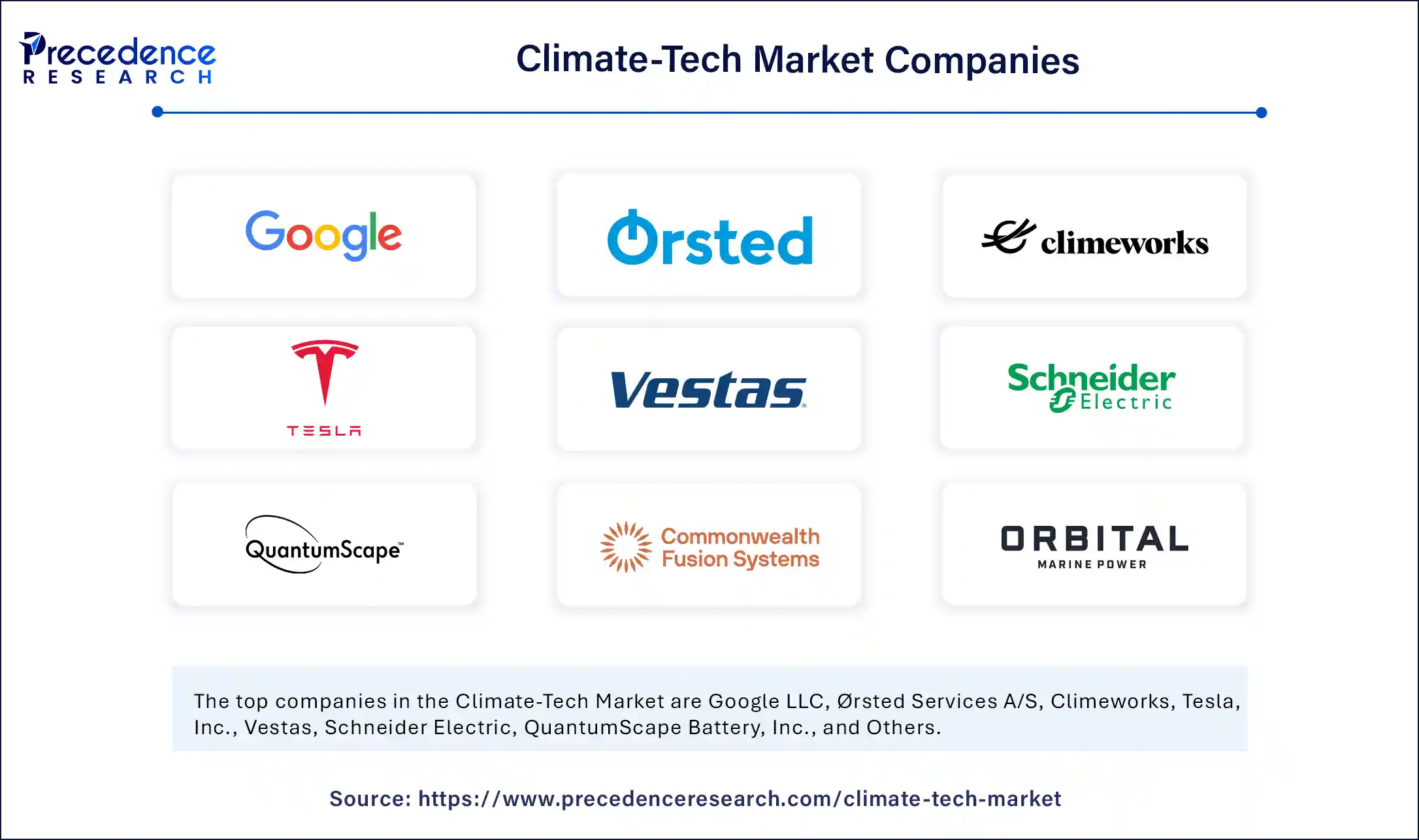Climate-Tech Market Size and Forecast 2025 to 2034
The global climate tech market size accounted for USD 25.36 billion in 2024 and is predicted to increase from USD 31.68 billion in 2025 to approximately USD 235.05 billion by 2034, expanding at a CAGR of 24.94% from 2025 to 2034.The climate tech market is expanding due to the growing use of climate-tech solutions in agriculture, energy, renewable energy, carbon capture (CCUS), transportation, circular economy, waste management, and green building.

Climate Tech Market Key Takeaways
- In terms of revenue, the global climate tech market was valued at USD 25.36 billion in 2024.
- It is projected to reach USD 235.05 billion by 2034.
- The market is expected to grow at a CAGR of 24.94% from 2025 to 2034
- North America dominated the climate tech market with a major share of 37% in 2024.
- Asia Pacific is expected to grow at the fastest CAGR in the upcoming period.
- By end user, the energy and utilities segment captured the biggest market share in 2024.
- By end user, the transportation and logistics companies segment is expected to grow at the fastest CAGR in coming years.
- By technology, the renewable energy technologies segment held the highest market share in 2024.
- By technology, the sustainable agriculture technologies segment is the fastest-growing during the forecast period.
How is Artificial Intelligence Transforming the Climate Tech Market?
The integration of Artificial Intelligence into climate tech has the potential to revolutionize various aspects of the market, including renewable energy optimization, carbon emission reduction, and climate modeling. AI integration in climate tech solutions is fueling market growth by enhancing decarbonization technologies. This supports industries in optimizing energy consumption, minimizing emissions, and streamlining carbon management. AI's real-time analysis of large datasets has significantly advanced energy efficiency and sustainable manufacturing.
In climate change mitigation, AI can lower carbon footprints across multiple sectors. AI algorithms contribute to energy-efficient building designs, low-emission transportation routes, and advancements in carbon capture. Moreover, AI-based planning models facilitate more effective energy grids, improve disaster readiness, and prioritize climate adaptation strategies for vulnerable communities.
U.S. Climate-Tech Market Size and Growth 2025 to 2034
The U.S. climate tech market size was exhibited at USD 6.57 billion in 2024 and is projected to be worth around USD 62.14 billion by 2034, growing at a CAGR of 25.19% from 2025 to 2034.

What Made North America the Dominant Region in the Climate Tech Market in 2024?
North America registered dominance in the market and accounted for the largest revenue share in 2024, fueled by increased public awareness of climate change and environmental concerns. This drives demand for sustainable energy solutions. Increased focus on energy storage research for diverse applications is also a major factor. North America's strong venture capital investment, supported by a developed startup ecosystem, significant institutional investor participation, and robust regulatory frameworks, further fuels market growth.
The U.S. is a major player in the market. The U.S. boasts a strong financial infrastructure, including angel investors, venture capital firms, and a well-developed capital sector. In August 2022, the Inflation Reduction Act was signed into law, allocating $369 billion in investment incentives to tackle climate change and energy security challenges. This includes research loans, tax credits, and grants to boost domestic manufacturing of solar panels, wind turbines, electric vehicles, batteries, and essential components for clean energy storage and production. Clean electricity investment and production tax credits, along with grants and loans for clean energy infrastructure, including electric transmission development, are driving market growth in the United States.

What Opportunities Exist in the Asia Pacific Climate Tech Market?
Asia Pacific is expected to experience the fastest growth during the forecast period. Emerging economies in the region face severe environmental issues like air pollution, water scarcity, and flooding, posing significant challenges to future growth, regional stability, and food security. These risks are driving governments and industries to adopt climate-tech solutions, boosting market growth. Asia Pacific countries are developing sustainable expansions to accelerate their transition to carbon neutrality and build resilient economies, further increasing the demand for climate-tech solutions.
Within Asia Pacific, China leads the market due to the rising investment in clean technologies, such as solar modules, batteries, and wind turbines, accounting for 76% of this investment in 2024. China has seen significant growth in renewable capacity over the past two decades. As the world's largest energy consumer, the biggest producer and consumer of coal, and the top carbon dioxide emitter, China's manufacturing sector, which accounts for two-thirds of its total energy consumption, drives market growth.
India's energy demand is rapidly increasing due to quick economic development, climate-related heat stresses, and urbanization. With a population of 1.36 billion, India's growing energy needs are fueling the demand for climate-tech solutions. India also has vast solar energy potential, with around 5,000 trillion kWh of energy annually incident on its land area, receiving 4-7 kWh per sqm per day in most parts. This offers significant scalability for solar photovoltaic power, further contributing to market growth. The transition to a circular economy, which aims to reduce waste and reuse resources, further supports market growth.
Market Overview
The climate tech market is rapidly expanding due to advancements that tackle environmental issues by decreasing greenhouse gas emissions, improving resource efficiency, and fostering biodiversity conservation. These technologies drive economic growth through job creation, cost savings, and new market avenues. Integrating climate tech into business strategies boosts corporate social responsibility (CSR) and strengthens brand reputation. Companies that prioritize sustainable practices often experience heightened customer loyalty and a competitive advantage.
Furthermore, aligning with environmental regulations allows businesses to evade penalties and take advantage of incentives aimed at promoting sustainable practices. Government policies and incentives play a vital role in fostering a supportive environment for climate tech investments. Tax breaks, subsidies, and grants ease the financial burden of new projects, encouraging greater private sector participation. Regulatory frameworks that require emission reductions and endorse renewable energy use further propel investment in climate technologies.
What are the major factors driving the growth of the climate tech market?
- Growing electrification of everything generates significant energy savings by enlarged efficiency in transport, households, industry, and construction, and lessens emissions and decarbonizes energy supply chains, which increases the demand for solar, wind, heat pumps, EVs, and smart grids, which contributes to market growth.
- Increasing funding in nature restoration to restore biodiversity, lessen the impacts of disasters, and revitalize cities. Incorporating nature-based solutions (NBS) in the public infrastructure and disaster-challenges-reduction efforts creates opportunities for jobs, both during the implementation of the project and over the long term, which contributes to market growth.
- Increasing trend of climate resilient cities in their ability to adapt, survive, and thrive in the face of climate-related stresses and shocks. As a major city builds its climate resilience, it withstands these challenges while breaking silos, solving co-benefits which address the intersectionality of its challenges and maximizing the value of money spent in reducing and supporting to avoid the challenges of future shocks and stresses, this cause the growth of the market.
- Innovations in renewable energy, energy storage, smart grids, sustainable agriculture, and other areas are driving down costs and improving the efficiency of climate-tech solutions. These advancements make climate-tech more competitive and attractive to investors and consumers.
Market Scope
| Report Coverage | Details |
| Market Size by 2034 | USD 235.05 Billion |
| Market Size in 2025 | USD 31.68 Billion |
| Market Size in 2024 | USD 25.36 Billion |
| Market Growth Rate from 2025 to 2034 | CAGR of 24.94% |
| Dominating Region | North America |
| Fastest Growing Region | Asia Pacific |
| Base Year | 2024 |
| Forecast Period | 2025 to 2034 |
| Segments Covered | End User, Technology, and Region |
| Regions Covered | North America, Europe, Asia-Pacific, Latin America, and Middle East & Africa |
Market Dynamics
Drivers
Expansion of Climate Tech Startups
Climate tech startups are emerging as powerful drivers in the worldwide response to climate change, offering transformative solutions that address critical risks like clean energy production, greenhouse gas emissions reduction, and ecological conservation. These ventures not only develop innovative technologies but also play a vital role in shaping consumer behavior by promoting environmental awareness through eco-friendly products and services. By encouraging the adoption of sustainable practices, they contribute to a broader cultural shift where environmental responsibility becomes embedded in everyday life. As a result, climate tech startups are not just responding to the climate crisis; they are creating a path toward a greener, resilient global economy.
Environmental Concerns and Government Regulations
The rising concerns about climate change, including extreme weather events, rising sea levels, and resource scarcity, are major factors driving the growth of the climate tech market. These concerns are pushing governments, businesses, and individuals to seek solutions to reduce greenhouse gas emissions and mitigate climate impacts. As a result, governments worldwide are implementing policies and regulations to promote climate action. These include carbon pricing mechanisms, renewable energy mandates, emission standards, and incentives for green technologies. These policies boost the demand for climate-tech solutions.
Restraint
Technological Challenges and High Cost
The critical risks in the development and optimization of climate technologies are the lack of access to relevant, high-quality data, which significantly hinders accurate evaluation of environmental impacts, performance metrics, and overall system effectiveness. This issue is particularly pronounced in sectors such as Carbon Capture and Storage (CCS), where companies striving to reduce industrial emissions often face barriers in obtaining real-time data on emission levels and capturing efficiency. Some climate-tech solutions, such as renewable energy projects and carbon capture technologies, require significant upfront investments. These costs can be a barrier to entry, especially for small businesses and developing countries.
Opportunity
Advancements in Carbon Capture, Utilization, and Storage Technology
The rise of Carbon Capture, Utilization, and Storage (CCUS) technologies offer climate tech innovators a chance to turn emissions reduction into profit. CCUS technologies can capture carbon dioxide emissions from industrial sources and power plants. These technologies can be used to store carbon dioxide underground or to convert it into valuable products. Moreover, new methods like direct air capture and CO₂ use (e.g., for fuels and materials) are changing carbon management from a cost to a revenue source. This shift helps the climate and boosts sustainable industrial growth.
End User Insights
Why did the energy & utilities segment dominate the market in 2024?
The energy & utilities segment dominated the climate tech market with the largest share in 2024. This is mainly due to stringent environmental regulations imposed by governments worldwide, pushing energy and utility companies to adopt cleaner technologies. This sector is a major source of greenhouse gas emissions globally. This creates a strong need for technologies that can reduce emissions, such as renewable energy sources, energy storage, and carbon capture.
Energy-efficient tech cuts costs for businesses and homes by lowering energy bills. Renewable energy boosts national energy security and protects against price spikes. Climate tech builds a resilient economy by tackling climate change challenges like resource scarcity. Innovations in climate tech address environmental risks by cutting emissions, improving resource use, and protecting biodiversity.
The transportation & logistics companies segment is expected to grow at the fastest rate during the forecast period. The growth of the segment is attributed to the increasing adoption of electric vehicles (EVs), including cars, trucks, and buses. This shift reduces reliance on fossil fuels and lowers greenhouse gas emissions. Green transportation, utilizing hydrogen fuel cells and EVs, lessens the environmental impact of transport. Climate-tech services in transportation and logistics, like electric vehicles, carbon-neutral shipping, and efficient routing, are designed to mitigate environmental challenges. Climate tech solutions helping logistic companies to optimize logistics operations. This includes route planning, efficient warehousing, and the use of data analytics to reduce fuel consumption and emissions.
TechnologyInsights
How does the renewable energy technologies segment dominate the market in 2024?
The renewable energy technologies segment dominated the climate tech market with the largest share in 2024, driven by technologies like wind and solar power. These offer clean alternatives, curbing fossil fuel emissions from electricity generation. This represents an energy-saving solution across industries, transportation, and buildings, supporting lower energy emissions and consumption. Climate technology further contributes to enhancing the resilience of communities and ecosystems in the face of climate change.
The sustainable agriculture technologies segment is expected to grow at the fastest rate over the forecast period. The sustainable agriculture technologies segment is projected to experience the fastest growth during the forecast period. Climate tech is reshaping the future of agriculture and food by reducing emissions, improving supply chain resilience, and accelerating the Net-Zero transition. Innovation is increasing in areas like precision agriculture, vertical farming, alternative proteins, and smart packaging, creating resilient, low-emission food systems. Climate-smart agriculture transforms agriculture by adapting to climate variations, enhancing resilience, and promoting resource-friendly practices.
Recent Developments in the Market
- In April 2025, DPIIT collaborates with GEAPP to spark climate-tech entrepreneurship in India. This partnership, with a provision for extension, will help early-stage climate-tech startups through mentorship, funding access, pilot opportunities, and market linkages. The initiative seeks to build a strong pipeline of scalable, investable ventures aligned with India's net-zero ambitions.
(Source: https://www.pib.gov.in) - In April 2025, the climate tech sector is on the verge of recovery as venture capital (VC) is flowing into energy, manufacturing, and carbon tech, according to the latest report from Silicon Valley Bank (SVB), a division of First Citizens Bank. Furthermore, Climate tech funds are outperforming overall VC, reaching a 9% higher internal rate of return (IRR) in the 2020-2024 fund vintage.
(Source: https://www.prnewswire.com) - In January 2025, Cambridge Cleantech, Cambridge Consultants, part of Capgemini, and EIT Climate-KIC announced the launch of the first SuperCluster ClimAccelerator, an innovative programme designed to accelerate high-impact industrial decarbonisation startups across the UK, France, Germany, Belgium, and the Netherlands.
(Source: https://www.cambridgecleantech.org.uk) - In March 2024, Montauk Climate, an incubator dedicated to creating technology companies at the forefront of climate, infrastructure, and energy transitions, announced its launch today with $8.5 million in operating capital. The round was led by Amplo Founder and Managing Partner, Sheel Tyle.
(Source: https://www.businesswire.com) - In February 2024, HSBC announced a partnership with Google Cloud to accelerate climate mitigation and resilience through support and financing for organizations in the Google Cloud Ready Sustainability (GCR-Sustainability) programme. GCR-Sustainability is a authentication programme for companies alng with solutions available on Google Cloud that supports cinsumers to achieve goals including carbon emission reduction, increased sustainability in value chains, and processing of ESG data to help identify climate challenges.
(Source: https://www.businesswire.com)
Climate-Tech Market Companies

- Google LLC
- �rsted Services A/S
- Climeworks
- Tesla, Inc.
- Vestas
- Schneider Electric
- QuantumScape Battery, Inc.
- Commonwealth Fusion Systems
- Orbital Marine Power.
- First Solar.
Segments Covered in the Report
By End User
- Energy & Utilities
- Manufacturing Industries
- Transportation & Logistics Companies
- Agricultural Enterprises
- Government & Regulatory Bodies
- Commercial & Residential Sectors
- Non-profit Environmental Organizations
By Technology
- Carbon Capture, Utilization, and Storage (CCUS)
- Renewable Energy Technologies
- Energy Storage Technologies
- Climate Risk Monitoring and Data Analytics
- Sustainable Agriculture Technologies
- Others
By Region
- North America
- Europe
- Asia Pacific
- Middle East & Africa
- Latin America
For inquiries regarding discounts, bulk purchases, or customization requests, please contact us at sales@precedenceresearch.com
Frequently Asked Questions
Ask For Sample
No cookie-cutter, only authentic analysis – take the 1st step to become a Precedence Research client
 sales@precedenceresearch.com
sales@precedenceresearch.com
 +1 804-441-9344
+1 804-441-9344